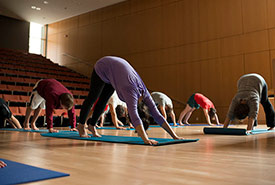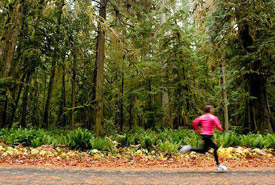Natural wellness solutions in the workplace

Yoga in the workplace (Photo by Jeremy Hess Photography/Wikimedia Commons)
Whatever you’re in the middle of, stop for a moment and run through this quick checklist of questions about your perceived state of health:
Do you experience tightness or pain in your neck while on the job?
Do your eyes feel dry or tired from staring at a computer/phone screen?
Do you need caffeine to get through the work day?
Do you experience lower back pain from prolonged sitting?
Do you feel a periodic break for fresh air is beneficial?
If you answered yes to most of these questions, incorporating some natural wellness routines may benefit you in your workplace.
What is workplace wellness?
Simply put, it is any practice, activity or resource that promotes and supports healthy behaviour in a workplace. It is a concept that encompasses many aspects of healthy living, including physical and mental health, work-life balance, occupational health and safety, cessation of unhealthy habits, and more.
When you’re feeling great at work, productivity and job satisfaction increase, while stress levels go down.
In recent years, more and more research points to the benefits of nature contact and the positive effects on the brain. And cultivating nature connections in the workplace has shown to promote better health.
Where to start?
Kick-starting a new routine or habit can be daunting, and requires even more motivation to stick with it. Like any fitness plan, a wellness routine can start to make good progress, and then take a hit when unexpected circumstances, such as sickness or high demands at work, throw it off kilter.
To help you re-engage and commit to being well at work in the new year, here are some activities that staff at the Nature Conservancy of Canada (NCC) recommend:
Log those miles daily

Running in nature (Photo from Masterfile)
If your work leaves you feeling like you’re run off the ground constantly, it’s time to take a breather and go outside for some fresh air. The Ministry of Labour states that most employees are entitled to a 30-minute meal break for every five hours of work under the Employment Standards Act, and there may be breaks agreed upon between employer and employee outside the eating period. Why not use part of these breaks to take a brisk walk outdoors?
Many people fall into the habit of eating at their desk, or working through lunch for various reasons, but the truth is, you can work down to the last minute of your day and still feel like there’s more work to be done. Ultimately, it’s up to you to schedule rest periods and make an effort to put healthy habits into practice.
Even a daily brisk, 10-minute walk can have a positive impact on fitness and weight. And if your workplace is not on the ground floor, get your blood pumping and a few extra steps in by taking the stairs. Try wearing a pedometer, or bring along your phone installed with a fitness app to track your daily activities.
De-stress with group yoga
Lunch-time yoga at the boardroom of NCC’s Calgary office has become a regular sight. People file in with their yoga mats on this mid-day break to enjoy the camaraderie and workout. Practicing yoga has lots of benefits; it improves strength and tone, flexibility, energy and respiration, and not to mention mental clarity and concentration. “It's a great de-stresser, and it gets us away from our desks for 45 minutes,” says Gayle Roodman, NCC's manager of editorial services, who is a regular participant. Staff have also taken their mats outdoors in warmer weather, to practice in a nearby park.
Go for a whirl on the ice

The inaugural lunch-time skate at a rink by NCC's Guelph office (Photo by NCC)
NCC staff in Guelph, Ontario, have been walking or cycling to their downtown office in warmer months. To stay active in the depths of winter, they’ve banded together for weekly lunch-time skating. “Health and wellness is very much on the top of our minds,” says Kristyn Ferguson, program director for central Ontario-west at NCC. “Because we’re a smaller office, it’s easier to get a good contingent of the staff here onboard with group activities.”
Out west in Invermere, British Columbia, office staff have been enjoying their wellness break at Lake Windermere, which has stunning ice conditions, not to mention being backed by the snowy peaks of Mount Nelson. Staff in BC are encouraged to share what they are doing for health and wellness, as it is an aspect of work culture that management values deeply.
Other ideas:
Stand and work
The next time you have a team meeting, try standing instead of sitting. Standing (or sit/stand hybrid) work stations are another great alternative for the typical office desk. Trading your chair for an exercise ball can also help sneak in stretches and movement throughout the day.
Tai chi
This low-impact, slow form of exercise promotes postural stability, improves breathing, mindfulness and whole-body coordination — no equipment or special clothing required. The motions are generally circular and fluid, with periodic pauses. Some movements and poses are even inspired by nature, such as “white crane spreads its wings" and “part the wild horse’s mane.”
Do you have some tips on how to stay active at work? Share them with us in the comments below.
Bring a little nature indoors
Unless your company is heavily invested in green architecture, like Google which revealed plans to develop terraced office buildings with green roofs and pathways with cascading hillscapes, consider creating a personal green space at your corner of the office. Indoor plants make great decorations and they even clean the air. Some offices opt to create a green wall where plants organized vertically along a wall. Resting your eyes by periodically looking at these green spaces can help with reducing eye fatigue.
Disclaimer: The suggestions on this article do not replace the recommendations from your professional health-care provider.


